
Eye On
A Motion Picture Company Gets Sirius
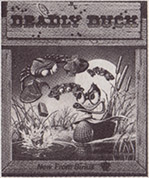
While Universal Pictures is dipping into its film library to produce videogames based upon that studio’s most popular films — Frankenstein, Dracula, Smokey and the Bandit, among others — its cross-town rival Twentieth Century Fox is busy inventing new themes for its line of home video cartridges.

The cartridges are being produced by Sirius Software, marketed by Fox under the name of “Games of the Century.” The first four titles in this Atari-compatible series are just now reaching the marketplace. They are:
Deadly Duck: an army of crabs has taken to the air and, armed with bricks and bombs, descend in marching ranks upon the web-footed hero. But Deadly Duck is thus-named for a reason. His bill is actually a gun barrel, which can unleash a fusillade of crab-cracking bullets.
Worm War I: the citizens of Teriyaki city are set upon by hordes of monster worms. These creatures slither about the city, moving around buildings as they try to reach the player. s entrenchment. All that stands between the once-great metropolis and the mutant wrigglers is a tank armed with worm repellent. Unfortunately, your tank has only a limited amount of fuel …
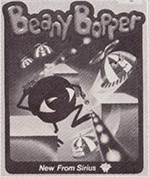
Beany Bopper: bothersome Beanies are buzzing the city, their propeller tops whirring. Nothing stops the irritating invaders — except for the amazing one-eyed Beany Bopper. Accoutered with a laser rifle which can pivot 360 degrees, the rotund hero must destroy the Beanies before they put the Bopper’s eye out.
Fast Eddie: Eddie is on a scavenger hunt, shimmying up and down ladders to collect sundry prizes. The problem is he’s not alone. There are pesky sneakers which run after him and grind the poor fellow into the ground.
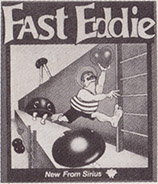
The film company has entered the field as part of an objective to be a prime software supplier in a variety of home video capacities. It was Fox which helped to create the video cassette field by licensing films such as Planet of the Apes and The French Connection to software manufacturers in the medium’s early days, when the prophets were predicting that no one would pay $50 to own a film.
Frank O’Connell has been named president of the new division, coming to Fox from Mattel’s Intellivision wing where he was in charge of sales and marketing.
Games of the Century began its campaign of TV commercials last month, spots which will continue through December for these four games. New cartridges will be released early next year. There are, at present, no plans to produce software for O’Connell’s alma mater.
Unmoving Pictures

If movie studios can invade the videogame market, there’s no reason the arcades can’t strike back.
Pacific Novelty Manufacturing, headquartered in Marina del Rey, California, has a do-it-yourself picture center for arcades. Unlike those quaint old booths which spit out four photos for a quarter, this sleek unit coughs up a variety of computerized portraits.
You can have your face on a hundred dollar bill or on a “wanted” poster, or you can print up a standard portrait or four mini-portraits just in case you have a lot of fans. Though the price is many times what it was for the old brown-tinted photos, the thrill of being digitized is worth the expense.
As For The Rest Of You …
Our other readers might be more interested to learn that Activision is making a huge effort to distribute its games overseas. Twenty-five countries are the object of this push, culminating this month with the release of Chopper Command and Ice Hockey in Australia, Canada, England, France, Spain, South America, the Far East, and other sites around the globe.
The cartridges are being advertised on television and, with this current push, the campaign makes Activision games available in seventy percent of the international market.
When asked if Activision intends to provide videogames for the Space Shuttle, one staffer quipped, “I’d be afraid to let them have Star Master, just in case they got carried away.”
You Can’t Please Anyone
As if Mrs. Scott hadn’t been sufficiently piqued, several readers wrote to complain that we hadn’t done a good job reviewing Air Traffic Controller in our last issue because, as Max Bent complained, “How can you cover a game and not show the screen?”
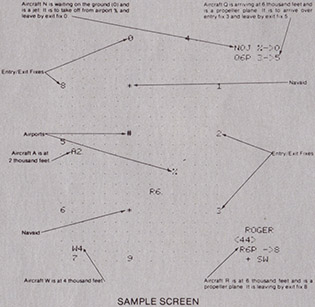
Dan Kelleher, Josh Trupin, Sandy Koufax (not the ballplayer; we got excited, too, and called), and Mr. Bent: here you are, the Air Traffic Controller screen. Fact is, we ran out of space last issue and had to drop it. We were too busy trying to land the bloody planes to bother with the grid.
Our thanks to Creative Computing Software for helping to wipe the egg off our faces. Now if they could only tell us how to function under six thousand feet …
The View From The Cellar
Videogaming Illustrated’s computer wizard Martin Levitan has worked miracles with Air Traffic Controller, even while the rest of the staff has stumbled from one calamity to another. However, Levitan isn’t the only videogame champion around. There’s Ice Hockey’s Ted Leibowitz, of course, as well as high scorers we’ve cited in previous Eye Ons.
Now there are the titans of Odyssey, championship-level players whose scores have been recorded by the company and reported in Odyssey Adventure magazine.
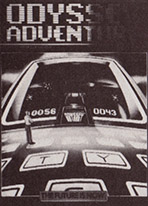
Some of the more noteworthy achievements:
*Michael Speziale of Niles, IL garnered 832 at Cosmic Conflict
*Stephen E. Bores of Philadelphia, PA scored the ultimate 9,999 at K.C. Munchkin
*Dave Dahlin of Sumner, WA tallied 173 at Monkey shines
*Kenny Jordan of Southgate, MI struggled to 7,510 points playing UFO — hopefully by following the patterns we laid out in our first issue.
If you have a high Odyssey score you’d like to stack against the champions, send a photo of your screen to Odyssey Adventure at 30400 Van Dyke, Warren, Ml 48093.
Things Not To Do
They warned us! Last issue we reported how various physicians are busy decrying videogames as dangerous to our health. We scoffed at much of what they had to say. Now, however, there is proof that videogames are harmful.
Here it is, anti-gaming watchdogs, the evidence you’ve been waiting for! And from the mouth of Gottlieb, no less, one of the world’s foremost manufacturers of arcade attractions.
In the manual which accompanies their pinball/videogame Caveman, Gottlieb warns that you may die if you do not short the anode plug on the picture tube. “The color monitor contains high voltages,” they stress, “delivering lethal quantities of energy.”
Proof positive that you should give up videogaming — at least if you’re the type who really gets “into” the pastime.
You Are There
While we’re on the subject of Activision, this publication actually received a nasty letter from Judith Scott, of Louisville, KY, complaining that in our first issue we should have provided a photograph of Activision’s new production plant. “After all,” she wrote, “if the company president is so proud of it, the least you could do is show us why.”
Well, we happen to think it’s an odd request; who knows what direction our magazine would take if we ran pictures of everything of which Jim Levy is proud.
Nonetheless, the expense of chartering a helicopter and dispatching a photographer is minimal compared to the joy we herewith bring to Mrs. Scott — and, we hope, to President Levy.

For Pros Only
Just in case you have the urge to become a professional videogame repairperson and go poking around safely inside Caveman and its kin, Videogaming Illustrated offers you this informal look at one of the more fascinating “tools of the trade.”
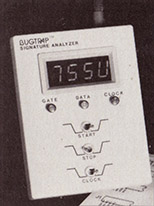
The unit is called a “signature analyzer” and trouble-shooters use it to search for flaws or “bugs” in microprocessor-based products. It does this through five simple attachments. Wires are attached to a power source, a ground — no danger of blowing yourself up if you forget, the analyzer simply won’t work — a start switch, a stop switch, and a clock signal.
Mike Wicksted, cofounder of Bugtrap Instrumentation, manufacturers of the gadget, told us, “The clock signal gives you a measurement window which allows you to chart the compressed data stream generated after you start the unit.” Which means, in English, that you use the signature analyzer to find out where there’s a break in the system.
If a life spent mending ailing videogames appeals to you, you might want to drop a line to Cal’s Coin College. The training takes only two weeks in residence and, according to owner Cal Clifford, “We teach our students to read the schematics which come packed with the game, and to apply what they’ve read. You can’t repair videogames without knowing that.”
Cal’s school — the oldest in the country, now in its eleventh year — can be reached at PO Box 810, Nicoma Park, OK 73066.
Eat ‘N’ Ruin
Assuming you have no interest in becoming a video vet, you can always become a video restaurateur. Nolan Bushnell has done it: the man who sold Atari to Warner Communications in 1976 for over thirty million dollars has opened over fifty Pizza Time Theatres, combining food and video fun in a family environment. Destroying cities while one dines may seem dichotomous, but the venture is prospering.
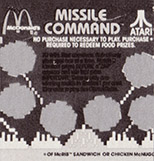
Other, more formidable companies have been testing the victuals-and-video waters with very promising results. McDonald’s spent over twenty million dollars in August and September promoting contests in which patrons played with “rub-away” contest cards and won Atari hardware and software, and Roy Rogers recently wrapped a Ms. Pac-Man exclusive, wherein players won free food and arcade versions of the game. Recently, Coca-Cola expressed interest in launching some kind of videogame tie-in as well.
Is there an atavistic link between dot-munching and lunch-munching, a subconscious reason why these two very satisfying acts go well together? We’re certain the psychiatrists will pounce on this one, and you’ll read about their findings right here.
It Had To Happen
This month and next will see the release of the first X-rated videogames, the work of a new company named “Mystique,” formed by the Caballero Control Corporation (manufacturers of adult videocassettes) and American Multiple Industries which is handling the programming of the games.
The first three releases are Atari-compatible, though Intellivision versions will be produced in the near-future.
The initial games are “Custer’s Revenge,” “Beat ‘em and Eat ‘em,” and “Bachelor Party.”
The Custer game features the infamous soldier avoiding Indian projectiles and moving cacti, the latter of which are unpleasantly abrasive to certain of his private parts. His task is to save a woman tied to a pole, who rewards him in the expected way. There were no details available on the other two cartridges.
Upcoming cartridges will be videogame adaptations of the most popular erotic titles produced by Caballero. In time, the Intellivoice capacity will be utilized so that the software can converse with the user.
The X-rated cartridges are only the first step in Mystique’s entry into the field. They felt that the novelty of an “X” rating would set them apart from other new companies, — and it has. Advance orders of the games have been in excess of one million, quite impressive in view of the cartridges’ $50 pricetag. But they hope to branch into family videogames as soon as possible, most likely by licensing existing characters from children’s television or the comic pages.
One can only wonder how this will fuel the arguments of the self-styled do-gooders who claim that videogames are a corrupting influence. We’ll keep you on top of it.
The Emperor Strikes Back
Meanwhile, the uncontested king of videogames is not letting new enterprises like The Games Channel, or even more direct competition like Activision fling it into paroxysms of terror. Atari has some ammunition of its own to help it continue carving out more and more of the marketplace.
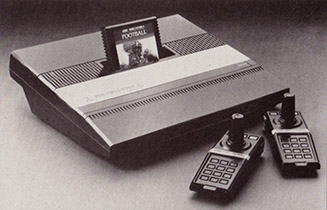
For one thing, this is the month the long-awaited Atari 5200 goes on sale. Retailing for $299, the unit offers graphics which are comparable to those of Intellivision and ColecoVision, and sound effects to match. This unit is not intended to make the current Atari system obsolete. Rather, according to Atari consumer electronics executive Michael Moone, “We have created two home game systems in the same spirit in which an automobile manufacturer builds different models to suit different tastes.”
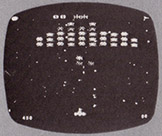
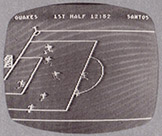
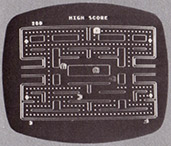
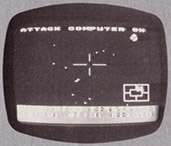
The 5200 controls are equally state-of-the-art, combining a joystick, paddle, and keyboard in a single hand-held unit. Early in 1983, Atari will introduce a Trak-Ball for the unit, giving players the same 360 degree control they currently enjoy only in arcade attractions such as Centipede and Kick. A voice synthesizer module will be released concurrently for yet another dimension of gameplay.
Ten game cartridges have already been shipped for the 5200, with home versions of the arcade hits Qix, Centipede, and Defender available in December. The retail price of these ranges from $31.95 to $39.95.
Nor is Atari letting their lower-priced videogame console sit idle. Thirteen cartridges are being introduced in the waning months of 1982, among them:
*EarthWorld: the first cartridge of the SwordQuest series, now on sale. The player roams through twelve zodiac rooms, using magical objects to open doors and release clues, battling attackers all the while.
*FireWorld: the second of the four SwordQuest games, to-be-released next month. It will be followed in 1983 by AirWorld and WaterWorld.
*Fail Safe: a more detailed version of the tank and plane warfare from Combat, now on sale.
*Frog Pond: previewed on page 00, on-sale next month.
*New versions of old sports cartridges: Baseball (available now), Volleyball (November), Football (December), and Soccer (January).
Finally, there is the Atari-Lucasfilms union which is sure to elevate gameplay to new heights. As announced last issue, the companies which create videogames and Star Wars have joined to develop innovative new coin-operated and home games. As Lucasfilms’ president Robert Greber points out, “Lucasfilms’ feature (film) operation, combined with its computer division, is a perfect partner to Atari. Together we intend to dramatically affect the evolution of electronic entertainment industry.”
Atari chairperson Raymond Kassar — “Yar” of the Yar’s Revenge videogame — adds, “The association is a natural since both companies hold a leadership position in our respective fields.”
What was that some stock analyst said about interest in videogames having crested?
New Kid On The Block
Just when you thought it was safe to go into your local video store, briefed on what’s coming from Atari and budgeted accordingly, your money is being tempted away by the first games of Spectravision. The cartridges will fit your Atari unit and, one hopes, your budget.
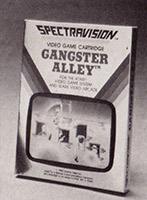
Currently on sale are:
*Gangster Alley, in which the player must gun-down criminals who appear randomly at windows in an abandoned warehouse — and at the same time be wary of Nitro Ed, who skulks about the roof of the building dropping grenades. As the game progresses, the player is forced to continue battling from daylight into night.
*Cross Fire, a space game in which the player must destroy the evil Morpuls which have been menacing the planet Tzoris (a Yiddish word meaning “troubles”). Not only must the player liberate the galaxy, but she or he must continually monitor energy and temperature gauges.
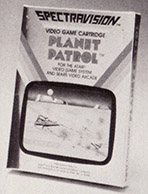
*Planet Patrol, a game which sends the player flying across alien terrain destroying enemy bases and dodging missiles. On occasion, the pilot must descend to refuel or rescue fallen allies. As in Gangster Alley, play carries from daylight to darkness.
*Tape Worm, a food hunt wherein Slinky the worm, Spanky the spider, and Beeky the bird all try to eat the player, who is moving about the screen trying to gobble down fruit.
*China Syndrome is the name of a disaster game set in Spectraville, where an earthquake has cracked the core of a nuclear power plant. Players must recover loose particles of radiation, doing so before there is a meltdown.
The New York based company expects to release new games early in 1983, although no plans have been formulated as yet.
It Was Bound To Happen
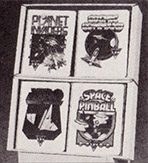
What with the profusion of “space” games, “invasion” games, and even “frog” games — to wit, Frogger, Frog Bog, and Frog Pond — we have at last seen the coming of the non-videogame.
Licenses to manufacture merchandise based on the most popular games is expensive, too costly for most small companies. Thus, they are showcasing games which don’t exist in genres which do, thus summoning up the “feel” of a Space Invaders or Asteroids.
Typical of this generic breed are notebooks now on the market. Boasting covers featuring Cosmic Command, Astro Collision, Space Pinball, and Planet Invaders, they save their creators inhibiting fees and allow everyone to get a piece of the videogaming pie — their own private vector, as it were.
Good trend or bad? The license holders are sure to cry “rip-off,” to which the manufacturers will retort “free enterprise.” For a slightly more objective view, tune in to next issue’s Keyboard.
Raiders Of The Lost Arcade

While Atari’s on the move in new technological avenues, they’re also beefing up some of the old ones.
As announced in our first issue, the lovable old Atari Video Computer System will have a prestigious new cartridge come December: Raiders of the Lost Ark, based on the hit film of the same name. At the time of the first report, little was known about the game. Now we can tell all!
Indiana Jones, the man in search of the lost ark of the covenant, must journey through thirteen rooms, pitting his skills against various natural and artificial dangers from snakes to pits. Everything that Indiana requires to collect the ark is distributed through the thirteen rooms: whips, knives, revolvers, swords, etc., each room amounting to a distinct game which Indiana must conquer.
Atari has developed a new and powerful computer coding system — one which no other cartridge manufacturer possesses — to put more on a VCS system than ever before.
Italivision
Activision isn’t alone in its thrust to capture a large share of the overseas market. Intellivision recently launched a massive campaign to make their games numero uno in Italy. No other videogame company has undertaken so massive a program in that country.
Using the international soccer matches in Spain as a topical hook, Mattel showcased their cartridge version of that sport in its advertising, capturing the rest of the audience by promoting Astrosmash, Space Battle, Star Strike, and Space Armada.
The cartridges are selling for 50,000 lire, or approximately thirty-five dollars. We can see it now. As international currency fluctuates, people fly overseas on massive cartridge-buying sprees …
Who Says They’re Bad For You
Detractors of computers take note: last month, the co-founder of Apple Computers, Stephan Wozniak, backed a three day rock music festival in San Bernardino County. CA. There were over twenty acts at the “U.S. Festival,” including Police, Tom Petty and the Heartbreakers, Fleetwood Mac, and Santana.
Wozniak said he was committed to keeping America vital by uniting the resources of business, technology, government, and education together. He added that the music was a means of showing people how by working together society could be improved.
Encore!
The Count’s Rising
No, not Dracula — although he’s rising to new life in a Universal Pictures videogame. In this case, however, the counts rising on the number of videogame companies producing cartridges for home consumption.
The latest to join the ranks is First Star Software. The company consists of two film producers and a programmer; naturally enough, they’re going to produce and sell games based exclusively on theatrical films and TV shows. Most of these will be based on upcoming works, much like book novelizations of screenplays tie-in to new releases.
There is both danger and reward in this track. The danger: obviously. tens of thousands of dollars can be spent deriving a game from a movie which turns out to be a flop. If the game is exciting enough, it may transcend the failure and take on a life of its own; if the film taints its tie-ins with the gloss of failure, forget it.
The rewards come when the film is a hit: if someone had an E.T. videogame on sale during the first few months of that films release. it might well have shattered all records.
Judge for yourself whether foresight or fortitude is behind the first stars from First Star. The initial releases tentatively slated to be Future Gold and Arcade, based on a pair of upcoming films.
AAA
Apologies: we managed to forget a few credits in our last issue, and announce them herewith. Isaac Asimov’s article “The New Learning” was originally published in Apple Magazine, reprinted because we thought it deserved a wide audience. Magnificent, too; is the work of Vincent DiFate. whose paintings graced pages 19, 25 and 29. The sketch on page 53 was also his. George Torjussen, an artist non-pareil in terms of realism. handled the chores on the Turbo art. Pat Boyette rendered the Headless Horseman which graced page 66.
Acknowledgements: this issue. Don Maitz provided the paintings on pages 19 and 31. Jim Steranko gave Ulysses its graphic dynamism, while Mr. DiFate returned with the awesome Zaxxon spread. Jim Laurier helped give Robotron some visual punch, and Pat Boyette did the honors once more on You Read it Here First. Boyette was also responsible for Pitfall Harry’s atmospheric backdrop.
Addenda: our coverage of the new science fiction thriller, Videodrome, originally announced for this issue, will appear in our fifth edition. The film was postponed until early next year. and there was no point previewing it so far in advance. For those of you who wrote with questions about our second issue. yes, the screen on the bottom of page 62 was from Astrocade’s Conan. As for the book pictured on page 64. that’s a new Lyle Stuart publication, better than most in the field. Lastly, in our first issue we reported that Filmation Studios of Reseda. CA, had landed the rights to do a cartoon series based on Pac-Man. Untrue. They had been negotiating with Bally to do so, and Filmation assumed the prize was theirs — but rival studio Hanna-Barbera actually took the honors. That’s show biz, folks.
Seven More Ways To Spend Money
Apollo is tempting your wallets along with the other companies: four new games are just going into release from the Texas-based software manufacturer. All are for your busy little Atari VCS.
In addition to the recently released Infiltrate, featuring an agent poking about a secret government site; Kyphus, a maze game set within a pyramid; and Guardian, a space battle game announced last issue as Cosmic Combat, the new Apollo cartridges are:
*Final Approach, an air traffic controller game created by an air traffic controller;
*Wabbit, a game about a wascally cweature who’s eating up a carrot patch, and the efforts of the farmer to get rid of the pest;
*Labyrinth, being the perils moving around an active volcano;
*Vat’s Incredible, a cartridge in which the player must stomp grapes into beverage.
Another space game announced last issue, Blue Angels, is still being worked on according to an Apollo spokesperson.
Apollo continues to produce some of the most innovative and ambitious cartridges on the market, and it will be interesting to see how they fare in the upcoming gift-giving season against the giants who have recently entered the field.
No Laurels Here
As if starting a new software company weren’t enough, the people at Spectravision have also released a new joystick which they call “Quick Shot.”
The selection of “Quick Shot” for a name is self-evident: it features a two action button system (one on the top, the other on the left side of the base). The stick itself is a contour hand-grip and, its most novel aspect, “Quick Shot” features a non-skid suction cup on its base. Stick it to the floor, table-top, etc., for one-handed operation.
“Quick Shot” can be used in conjunction with the Atari system, as well as its 400 and 800 computers. It also fits the Commodore VIC-20.
The Spectravision control sells for $13.95.
Tilting At Videogames
For the first time ever, Williams Electronics is offering a medieval game which gives players a chance to challenge one another in head-to-head competition or battle a common enemy — the videogame itself.
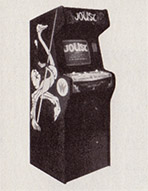
The recently released arcade game is called Joust, and it is one of the most exotic games ever created.
Each player begins the game mounted astride an ostrich-like being. The players operate interesting “flap” buttons as well as joysticks, flying their storks in search of adventure in Williams’ mythological world.
In the single-player game, as you romp about, enemy riders astride buzzards attempt to unseat you. A successful joust scores points for the player, turning the enemy into an egg that must be picked up before it hatches into an even more dangerous adversary.
In the dual-player mode, the waves are more complicated, including a rather vicious mode: called the Gladiator wave, it enrouages players to battle one another, awarding a cache of bonus points to the victor.
The animation in Joust is extremely life-like, with some of the more unusual sound effects one is likely to find in an arcade game.
Step Aside, Dukes
Videogames have done more than successfully work their way into our eating habits, they’re taking over cable television as well.
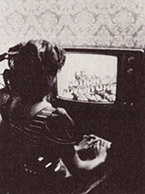
The Games Channel is a new system which offers videogames play twenty-four hours per day. Cable TV subscribers can pick from the top arcade and home games, the selection of which changes monthly. A minimum of twenty games is offered during any given month, five of which are replaced at the end of that period by new games.
The system becomes available once a special microprocessor unit is installed in the home (usually for a flat rate of fifty dollars). The fee thereafter is under fifteen dollars a month per subscriber. The games are loaded into the microprocessor via the cable: in essence, all you’re doing is “borrowing” the program. Because the “memory” of the microprocessor is so much more than most of the home games, the graphics are accordingly superior.
The Games Channel promises that there will always be a balanced blend of adventure, arcade, computer, educational, fantasy, and role playing games. They have made certain that the microprocessor can be used in other household applications as well.
If your local cable system does not offer this exciting new interactive capability, contact them or write directly to The Games Channel at 1438 North Gower St., Box 22, Hollywood, CA 90028.
Facetiae
The column which dares you to identify five popular home videogames based on the following verse.
I
Grief is such a major part
Of trips from France to Nome;
Here your troubles do not start
Until you head for home.
II
Don Quixote was undone
When windmills he did tilt at.
This game offers kindred fun
Plus more ways to be killed at.
III
Ice is nice, or so they say,
If you are playing hockey.
This time you must save the day
As a rebel space jockey.
IV
Enemies defend the trench
That your fleet craft must cross
Shoot ‘em or endure the stench
Of your world blown to dross.
V
Hunting treasure, to be frank,
Is what this game does best.
Either you will walk the plank
Or find the hidden chest.
Answers:
I: Lost Luggage, II: Barnstorming, III: The Empire Strikes Back, IV: Star Strike, V: Pirate’s Chase
Source Pages








